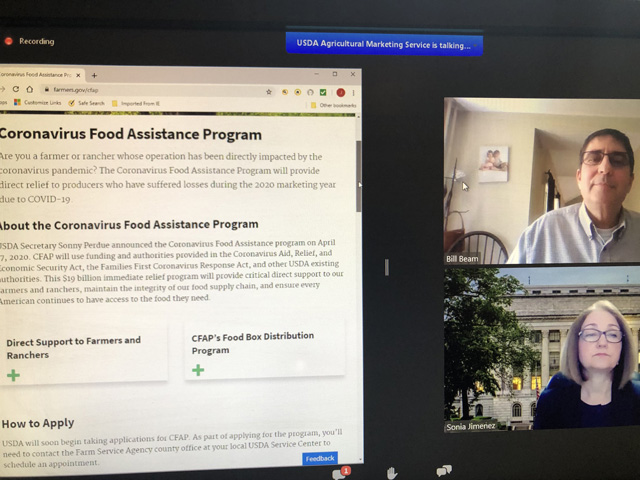USDA Short on CFAP Details
Sign-Up Date Still Not Set, but USDA Wants Producer Paperwork Prepared
GLENWOOD, Iowa (DTN) -- USDA still doesn't have a sign-up date for a new aid package dubbed the Coronavirus Food Assistance Program, but Farm Service Agency offices will start training for enrollment next week, according to a notice sent to state and county offices.
The department cannot provide full details on the $16 billion Coronavirus Food Assistance Program (CFAP) until the final rule is approved by the White House Office of Management and Budget. The rule was sent to OMB on May 5 and is still listed as pending review.
Still, USDA officials held a webinar on Thursday, providing some bare-minimum details of the program. Much of the 15-minute webinar was focused on forms that producers must fill out to be eligible for direct aid, especially if those farmers or livestock producers have never enrolled in aid programs through the Farm Service Agency.
USDA first announced on April 17 that it was releasing a $16 billion direct-aid package to producers from funds provided in the Coronavirus Aid, Relief and Economic Security (CARES) Act. The aid package is expected to provide $9.6 billion to livestock producers, $3.9 billion to commodity crop growers, $2.1 billion for fruit-and-vegetable growers and $500 million to farmers who grow other various niche products.
Sonia Jimenez, deputy director of the Agricultural Marketing Service for Specialty Crops, said on Thursday's webinar the CFAP package will provide aid to farmers who suffered market losses from January through April 2020, regardless of size, if they suffered an eligible loss.
P[L1] D[0x0] M[300x250] OOP[F] ADUNIT[] T[]
Payments were initially expected to be limited to $125,000 for each commodity with a $250,000 payment cap, but Agriculture Secretary Sonny Perdue told Brownfield radio last week that the payment limits have been adjusted after hearing from livestock groups regarding their financial losses.
Adjusted gross income for producers is expected to be capped at $900,000 unless at least 75% of a producer's income is derived from agricultural production.
Bill Beam, FSA's deputy administrator for Farm Programs and a farmer from eastern Pennsylvania, said on the webinar that USDA will begin taking applications for CFAP "soon," though the date is not known. Once that happens, producers can call their local USDA Service Center to set up a phone-call appointment, as the service centers are not meeting producers face-to-face due to coronavirus restrictions. Farmers can communicate through email with FSA employees, as well, or they can use online tools to fill out applications as well.
For farmers or livestock producers who have not traditionally received USDA aid, they will need to fill out a bevy of USDA forms detailing their legal entity, CCC-901; adjusted gross income, CCC-941; certification for income for those exceeding the adjusted-gross income limits, CCC-942; as well as AD-126 for conservation compliance. Those forms and others are listed on the website www.farmers.gov/CFAP.
Farmers can begin filling out that paperwork if it is not already on file with USDA. Beam also cautioned farmers to not send any personal information to USDA without first initiating contact through a phone call.
One question asked and answered during the webinar was in regard to Small Business Administration loans. Farmers and livestock producers remain eligible for USDA aid programs regardless of whether they have received Paycheck Protection Program (PPP) or Economic Injury Disaster Loans (EIDL).
Jimenez and Beam did not answer other questions submitted through chat on the webinar, but stated they would provide answers later. Farmers and ranchers had questions about how USDA would estimate the value per head for feeder cattle and fat cattle, for instance. Other farmers asked for more specific details about defining an eligible loss, or how producers should determine losses when part of a cooperative that only provides financial numbers once annually.
More specific details about commodities and losses will be provided when the rules are published in the Federal Register.
The full, 15-minute webinar can be viewed at https://www.youtube.com/….
Chris Clayton can be reached at Chris.Clayton@dtn.com
Follow him on Twitter @ChrisClaytonDTN
(c) Copyright 2020 DTN, LLC. All rights reserved.




